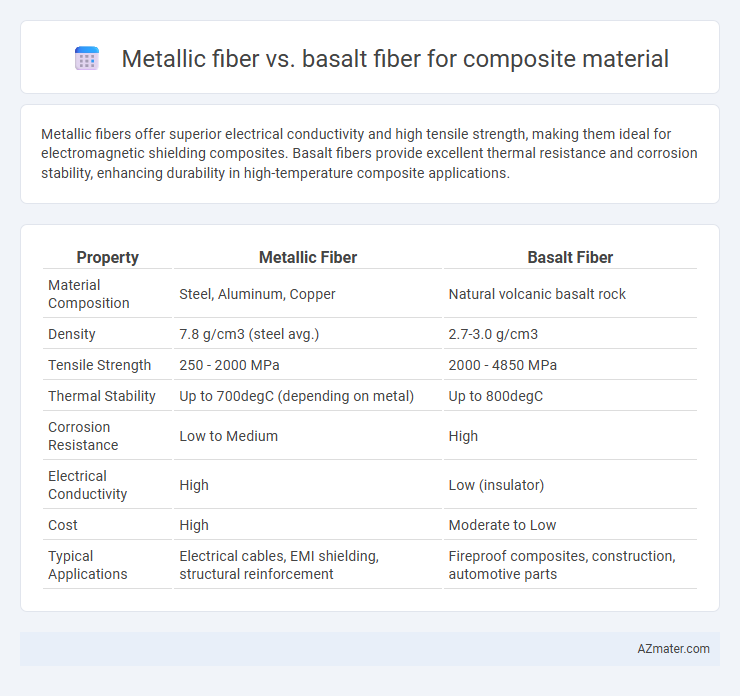Metallic fibers offer superior electrical conductivity and high tensile strength, making them ideal for electromagnetic shielding composites. Basalt fibers provide excellent thermal resistance and corrosion stability, enhancing durability in high-temperature composite applications.
Table of Comparison
| Property | Metallic Fiber | Basalt Fiber |
|---|---|---|
| Material Composition | Steel, Aluminum, Copper | Natural volcanic basalt rock |
| Density | 7.8 g/cm3 (steel avg.) | 2.7-3.0 g/cm3 |
| Tensile Strength | 250 - 2000 MPa | 2000 - 4850 MPa |
| Thermal Stability | Up to 700degC (depending on metal) | Up to 800degC |
| Corrosion Resistance | Low to Medium | High |
| Electrical Conductivity | High | Low (insulator) |
| Cost | High | Moderate to Low |
| Typical Applications | Electrical cables, EMI shielding, structural reinforcement | Fireproof composites, construction, automotive parts |
Introduction to Composite Materials
Composite materials combine two or more distinct components to achieve superior mechanical properties compared to individual materials. Metallic fibers, known for high tensile strength and electrical conductivity, enhance composite durability and performance under dynamic loads. Basalt fibers, derived from volcanic rock, offer excellent thermal resistance and corrosion resistance, making them ideal for high-temperature and chemically aggressive environments in composites.
Overview of Metallic Fibers
Metallic fibers, commonly made from steel, aluminum, or copper, offer high tensile strength, electrical conductivity, and excellent thermal resistance, making them ideal for reinforcing composite materials that require enhanced mechanical and thermal properties. These fibers improve the composite's durability, impact resistance, and electromagnetic shielding capabilities compared to basalt fibers, which are known for their chemical stability and thermal insulation but lower electrical conductivity. The integration of metallic fibers in composites benefits applications in aerospace, automotive, and electronics industries where strength and conductivity are critical.
Overview of Basalt Fibers
Basalt fibers, derived from volcanic basalt rock, offer superior thermal resistance, high tensile strength, and excellent chemical stability compared to metallic fibers used in composite materials. Their natural origin and corrosion resistance make basalt fibers ideal for lightweight, durable composites in aerospace, construction, and automotive industries. Unlike metallic fibers, basalt fibers provide enhanced insulating properties and reduced weight, contributing to improved performance and sustainability in composite applications.
Mechanical Properties Comparison
Metallic fibers exhibit high tensile strength and excellent electrical conductivity, making them suitable for applications requiring both mechanical resilience and electromagnetic interference shielding. Basalt fibers demonstrate superior thermal stability, corrosion resistance, and higher modulus of elasticity, resulting in better stiffness and durability in harsh environments. When comparing mechanical properties for composite materials, basalt fibers offer increased tensile modulus and temperature resistance, while metallic fibers provide enhanced ductility and impact toughness.
Thermal Resistance and Performance
Metallic fibers exhibit excellent thermal conductivity and high-temperature resistance, making them suitable for applications requiring heat dissipation and structural integrity under extreme heat. Basalt fibers offer superior thermal resistance with low thermal conductivity, providing effective insulation and stability up to temperatures of approximately 980degC. While metallic fibers enhance thermal performance by facilitating heat transfer, basalt fibers improve thermal insulation and maintain composite durability in high-temperature environments.
Corrosion and Environmental Stability
Metallic fibers, commonly made from stainless steel or aluminum, are prone to corrosion when exposed to moisture and harsh chemicals, limiting their environmental stability in composite materials without proper protective coatings. Basalt fibers exhibit superior corrosion resistance due to their natural silicate composition, maintaining integrity and mechanical properties in aggressive environments such as seawater or acidic conditions. The inherent environmental stability of basalt fibers makes them ideal for long-term applications where resistance to oxidation and chemical degradation is critical.
Weight and Density Considerations
Metallic fibers typically exhibit higher density values around 7.8 g/cm3, resulting in increased weight for composite materials compared to basalt fibers, which have a density approximately 2.7-3.0 g/cm3. The lower density of basalt fiber composites offers significant advantages in lightweight structural applications without sacrificing mechanical strength. Weight-sensitive industries such as aerospace and automotive favor basalt fibers to achieve enhanced fuel efficiency and performance through reduced composite density.
Cost and Availability Analysis
Metallic fibers generally have higher costs due to expensive raw materials and energy-intensive manufacturing processes, making them less accessible for large-scale applications. Basalt fibers offer a cost-effective alternative with raw material abundance from volcanic rocks, resulting in lower production expenses and greater availability worldwide. The economic advantage of basalt fibers drives their increased adoption in composite materials where budget constraints and supply chain considerations are critical.
Typical Applications in Industry
Metallic fibers are widely used in electromagnetic shielding, thermal management, and reinforcement in aerospace and automotive composite materials due to their high electrical and thermal conductivity. Basalt fibers find typical applications in construction, ballistic protection, and fireproof textiles because of their excellent mechanical strength, corrosion resistance, and thermal stability. Both fibers enhance composite materials but serve distinct industrial needs based on their intrinsic properties.
Conclusion: Choosing the Right Fiber for Composites
Metallic fibers offer superior electrical conductivity and thermal resistance, making them ideal for applications requiring enhanced electromagnetic shielding and heat dissipation. Basalt fibers provide excellent mechanical strength, chemical resistance, and thermal stability, suitable for lightweight, corrosion-resistant composite structures. Selecting the right fiber depends on the composite's performance requirements, with metallic fibers favored for conductivity-focused applications and basalt fibers preferred for durability and environmental resilience.

Infographic: Metallic fiber vs Basalt fiber for Composite material
 azmater.com
azmater.com